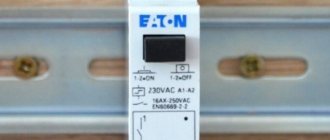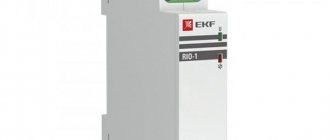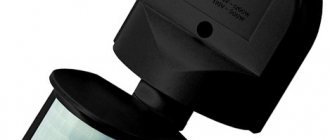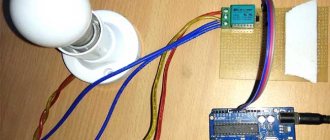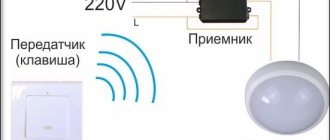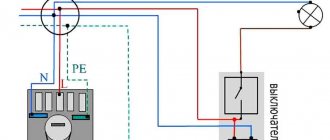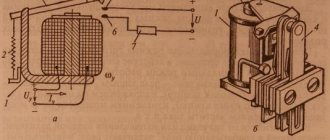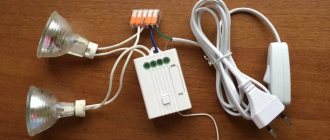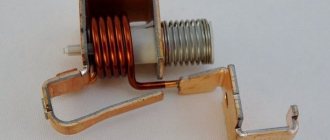When installing automatic lighting control systems, various types of switches can be used. Some devices, for example, marching and walk-through products, provide a fairly high level of comfort when controlling lamps, but the simplest and most convenient is a circuit with a pulse relay. Such a device can be in 2 different states, which can be controlled remotely. The pulse relay used to control lighting will be discussed in more detail below.
For what purpose are pulse circuit breakers used?
A feature of this type of relay is the ability to fix in any one position after applying an electrical signal to its contacts. Such bistability of an electronic element is convenient for controlling many devices and mechanisms, but in everyday life, it is most often used in circuits for switching on lighting devices. For example, lights in a long hallway can be switched off from different rooms, making it easy to “travel” through a house or apartment, always maintaining the required level of lighting where needed.
One of the advantages of a pulse device is the ability to “remember” the last position of the contacts, even in cases where there is a complete blackout of the electrical network, the last position of the contacts is retained.
The advantage of a pulse-type relay is also that low voltage can be used for its operation. Thanks to this electrical wiring, the switch can be located in a very humid area, such as a bathroom or basement. Thus, a significantly higher level of safety is achieved during the operation of electrical systems compared to conventional switches.
Where can I buy
You can purchase the device either in a specialized store or online in an online store. In the second case, the budget option for purchasing products on the Aliexpress website deserves special attention. For some products there is an option for shipment from a warehouse in the Russian Federation; they can be received as quickly as possible; to do this, when ordering, select “Delivery from the Russian Federation”:
| Impulse relay TOMZN | Impulse relay CHNT | Pulse relay SOLARD EPN510 |
| Surge and overload protection relay EARU | Voltage regulator SINOTIMER | BIS-402 Pulse relay |
Design and principle of operation
The design of the pulse device is very simple, but this fact is not a disadvantage of the product; on the contrary, the presence of a small number of elements can significantly increase the reliability of the product. Such an electronic device consists of the following parts:
- Reels.
- Core.
- Movable anchor.
- Contacts
The relay coil consists of a large number of turns of copper wire. During manufacturing, the conductors are treated with a special varnish, which eliminates the possibility of a short circuit (under standard operating mode of the device). The core consists of a magnetic material and is a movable element that acts on the armature, which, in turn, sets the electrical contacts in motion.
Thanks to the design features of the contact opening system in the pulse device, it is possible to achieve reliable fixation of these elements in any one position.
Second installation option
It will be much easier for car owners whose bumper already has space for mounting fog lights. Then you don't need to buy any fuses. All that is required is a pair of new fog lights and up to 100 centimeters of wire (in reserve).
This algorithm for installing PTFs is suitable not only for foreign cars, but also for all domestic cars on which the manufacturer has provided a mounting location for the optics. For example, on VAZ 2110 and 2114 cars, connecting foglights in this way takes no more than 20-40 minutes (and this despite the fact that the car owner has no experience installing such equipment on a vehicle).
Types of pulse relays
The most common electromechanical type of pulse device was described above, but modern devices of this type can be implemented on a control chip. This design consumes more power due to the constant standby state of the device, but produces less noise when the contacts operate.
Pulse devices equipped with a microcontroller have wider functionality. For example, in addition to the ability to fix the switch in a certain position, you can set the time to turn off the light (for devices equipped with a timer).
Electronic relays also have break contacts, but they are driven by an electronic circuit that controls the moment they are latched. Devices of this type can be installed in electrical systems with different supply voltages.
The main disadvantage of electronic relays is their low resistance to interference and voltage surges. In terms of cost, such products are also significantly inferior to electromechanical products (electronic IRs are more expensive).
Pass-through light switch
To control the lamps from two places, they do not install simple switches; pass-through SWITCHES are used, so named according to the principle of operation. Below is a visual comparison of their circuits.
The switch simply breaks or shorts the phase conductor passing through it, de-energizing or lighting the lamps.
The switch is designed differently, inside it, with each key press, the phase conductor is connected to one or the other internal contact. In this case, the phase does not break, but only transfers to the adjacent contact - because of this, the device is also called a changeover switch. Read on to find out why it is needed and how it is used.
Specifications
When installing lighting systems that will be switched on from a pulse device, it is necessary to take into account the basic parameters of such a product. If the device is not designed for the connection load or network voltage, it can instantly fail. In the documentation for the pulse device, the manufacturer indicates the most important characteristics. Among the main parameters that you need to know before deciding to use a particular IR model are:
- Output current - the maximum value of the current that appears in the coil when the armature moves (for electromechanical devices).
- Trip value - indicates the signal that causes the relay to operate automatically.
- Pull-in current is the minimum current value for the relay to operate.
- Return coefficient is the ratio of the armature output current to the retraction current.
When selecting and using a relay, you should also consider the voltage and current limits for which the relay is designed.
The device passport may also indicate the response time. There are fast-type products that turn on in 0.001–0.05 s and devices with a long delay (about 1 s).
Light control from several places using intermediate relays
An intermediate relay is, in principle, an ordinary relay that can perform the following functions (or one of them):
- Galvanic isolation,
- Transition from one voltage level to another (or from one type of current to another),
- Current amplification when the control current is much less than the contact current,
- Execution of logical functions,
- Reproduction of contacts (from one switching you can make 4, for example).
It is precisely the last function that will help us make pass-through and crossover switches on the relays, while using ordinary switches to control these relays.
The diagram will help you understand what is written:
Scheme with 2 pass-through switches and 2 relays. Switching on lamps from four places
That is, relays with their contacts imitate cross switches.
We can go further - we use 4 relays and 4 regular switches!
Circuit with 4 relays to simulate a circuit with 2 pass-through and 2 crossover switches
In the diagram, S1, S2, S3, S4 are ordinary familiar switches. People who are far from electrical and automation will find it easy and simple to understand this system.
Connection diagrams
A pulse relay can be used to control lights. To ensure the operability of electrical systems with installed switching elements of this type, it is necessary to correctly perform the work of connecting the conductors.
First of all, it should be borne in mind that a pulse-type relay is not equipped with any protection elements, therefore, if a short circuit occurs in the electrical wiring of lighting devices, not only the relay contacts may burn out, but also the ignition of any flammable objects located in the immediate vicinity of copper conductor. To minimize possible consequences, the installation of pulse relays should be carried out only after the machine (or fuses (plugs)).
Push-button switches are used to switch relay modes. Such elements of electrical fittings are equipped with spring elements that return the button to its original position immediately after the mechanical pressure on its surface ceases. This is a very important point, because if the contact is closed for too long, the coil winding may overheat and the product (electromechanical) will fail.
Many manufacturers of impulse switches indicate in the product documentation that it is impossible to supply electric current to the coil for a long time (usually no more than 1 s).
The number of switches with which a signal is supplied to the pulse relay is not limited in any way, but, in many cases, there are 3-4 buttons in the device connection diagram. This is enough to control the light from several places.
All push-button switches are connected in parallel to each other. This feature of controlling a pulse device allows you to use a significantly smaller number of wires, compared to other methods of installing a control system for one light device from different places. One wire of the contact system of switches is connected to the electrical wiring phase, the other is connected to the pulse relay (contact A1).
In addition to supplying the phase wire from the switches, the phase is connected to contact “2” of the pulse device. This ensures the transmission of a signal to turn it on (off), as well as providing the device with electric current to supply voltage to consumers (lighting devices).
“Zero” is connected to contact “2”. Lighting devices are connected to the “ground” not through a switching device. The neutral wire is connected to the lighting fixture from the neutral bus.
Physical placement of the pulse relay is possible both in electrical panels and in the immediate vicinity of the lighting device (installation is carried out in a junction box).
Requirements for installing fog lights
It is permissible to locate fog lamps directly in the headlights.
The rules for installing headlights are regulated by two regulations:
- GOST 8769-75 or SEV standard 4122-83;
- state standard of the Russian Federation GOST R 41.48-2004, corresponding to UNECE Rules No. 48.
Location of fog lights on a car
The general requirements are as follows:
- The installation location is located at a distance of no more than 400 mm from the side surface of the vehicle body. The distance is measured between the side plane and the outside of the headlight.
- It is permissible to install only two fog lights. The standards separately stipulate the mandatory installation of fog lights on tourist buses, as well as on vehicles operated on mountain roads.
- The lower edge of the fog lighting device is located at a distance of at least 250 mm from the road surface.
- Fog lights should have a horizontal viewing angle ranging from +15º to -10º, and a vertical viewing angle from +45º to -10º. It is unacceptable to block the headlights with vehicle parts within the specified angles.
- Fog lights must be connected in parallel with side lights.
- The lenses of the fog lamps must produce a beam of light located below the flow given by the low beam lamps.
- It is acceptable to use transparent filters or selective yellow color. It is unacceptable to use glass of different colors on the same car.
The standards do not have special requirements for installing fog lights on a car, so the owner can install the kit himself.
Pros of the device
The use of a pulse relay for organizing control of electric lighting has a large number of advantages. The main positive properties of such systems are:
- Relatively low price.
- Long service life.
- You can use an unlimited number of switches (buttons).
- Relatively low power consumption.
- Easier installation compared to main switches.
When using electronic devices, you can set the time after which the power will turn off.
Cons of a pulse relay
Pulse-type relays are not without their drawbacks. The most noticeable disadvantages of using such systems are:
- Generation of electrical noise.
- Quite a loud click when the contacts are turned on.
- Rapid wear of moving parts is possible (with very intensive use).
You can almost completely get rid of the listed disadvantages by installing electronic relays, but such devices will cost much more than electromechanical ones (2-3 times).
Tips and tricks
Before purchasing and installing a pulse relay, it would be useful to familiarize yourself with the most common errors that may arise at this stage. Experienced professionals who install switching systems of this type often advise adhering to the following recommendations:
- If you purchase an electronic pulse-type relay, it is better to give preference to models equipped with a timer. With this feature, you can set the power to automatically turn off after a certain period of time. This function will be very useful for organizing lighting on the street, as well as in rooms that are visited frequently, but not for long.
- If you plan to install backlit switches (buttons), you should check with the seller in advance whether the relay can work with such elements of electrical fittings. Many IRs are very sensitive to the appearance of even a small current in the electrical circuit, and the presence of a resistive element will lead to activation of the system. In addition, the device may deteriorate, because the coil will be constantly energized.
- During installation work, all parts through which electric current flows must be well insulated. For this purpose, you can use special heat-shrinkable tubes, as well as PVC insulating tape.
- If there is a small child in the house, then it is better to install the buttons to activate the relay higher. Such products are well insulated and practically safe during operation, but children often start playing with the buttons by holding them on for a long time. Such actions often lead to failure of electromechanical type pulse relays.
- Most models of pulse relays with a coil are designed for 220 V. Such products are very easy to connect to the electrical network, but if you need to ensure a high level of safety in wet rooms, you should choose 12 or 24 Volt models.
- If you need to install several pulse relays that will be used to turn off various lighting devices, then you should choose models with central control. Such a device can be forcibly turned off by applying electric current to one of its contacts. Therefore, if you connect several of these elements to one switch, you can turn off all the lights in the house with one press of a button.
- If there is no desire or opportunity to purchase new buttons to turn on the light using a pulse relay, then you can remake ordinary switches. For this purpose, it is necessary to install small springs under the keys so that after stopping pressing they return to their original position.
- When installing a large number of impulse switches, to save space, the buttons can be placed in one socket box.
A pulse relay is a very interesting product in its design and functionality, which can and should be used to organize more comfortable control of lighting devices. If a high-quality device is selected and the installation of the product is carried out without errors, then such a system will last for many years.
What will you need to install fog lights?
To install fog lights yourself, a minimum set of tools is required. The car owner must have knowledge and skills in working with electrical wiring, since the safe operation of the car as a whole depends on the correct installation.
- color electrical diagram of the car;
- nippers or side cutters;
- wire cleaning knife;
- terminal crimping pliers (terminal block);
- soldering iron
Set of materials required for installation:
- a set of fog lights suitable for installation in standard holes in the bumper or universal ones that are mounted on the surface of the bumper;
- stranded copper wire with a cross-section of 1.5-2 mm² with insulation capable of operating at low temperatures and resistant to gasoline and oil vapors;
- relay for turning on (standard headlight turn-on relays from front-wheel drive VAZ models are usually used);
- remote housing for installing a blade fuse;
- 30 A blade fuse;
- a control key that matches the interior design (preferably with a backlight);
- connectors and terminals for connecting wires to circuit elements;
- heat shrink tube of suitable diameter;
- electrical tape on a polyethylene or fabric basis;
- plastic ties;
- automotive corrugated hose for laying wires.
Set of fog lights for Ford Focus 3
